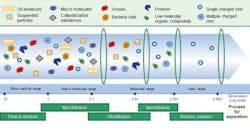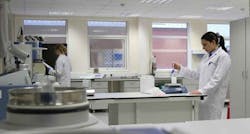Sustainable Ceramic Membranes for Wastewater Applications
By Paul Manison
Worldwide water scarcity, combined with an increase in population growth, is leading to the realization that water production and reuse must become more efficient. Industries that use large amounts of water, including food and energy, are increasingly on the lookout for sustainable filtration solutions that improve industrial water reuse efficiencies. While the vast majority of applications use either polymer or ceramic tubular membranes, new high-quality porous ceramic membranes are being developed as part of an innovative filtration system with the aim of improving filtration efficiency, reducing the amount of maintenance downtime and decreasing energy usage. These operational benefits can also result in reduced operating costs.
Filtration System Basics: Polymer and Ceramic Membrane Filters
Polymer or ceramic tubular membranes are currently used to clean, conserve and reuse water in a variety of industrial and communal wastewater applications, including wastewater plants, buildings and even cruise ships. Currently, polymer membranes account for around 75 percent of the membrane filtration market, with ceramics accounting for the majority of the remaining 25 percent, along with a small number of other materials such as metallic membranes making up the rest. Figure 1 illustrates the variety of filtration separation processes available and provides an overview of their use in particular applications.
The use of ceramic membranes is common in dairy production, and they are widely used for fruit juice clarification. Due to their lower purchase price, systems using polymer membranes are widespread in the wastewater filtration market. However, while polymer membranes are cheaper to manufacture than their ceramic equivalents, polymer systems require more frequent filter replacements.
The low resistance properties of polymer membranes, compared to ceramic, limit the number of applications in which they can be used. In general, the ceramic membrane system filtration module housing, which is often metallic, sets the limitations for processing aggressive media, rather than the filter itself. Inversely, when polymer membranes are used in harsh environments, the filter material will wear first. In addition, the flow rate through ceramic membranes can be greater than through polymer membranes for a given pore diameter. A ceramic filtration unit also requires lower pressure (and less energy) to circulate fluid.
As water reuse becomes a more important issue, some extremely demanding industrial applications are faced with the need to filtrate increasingly challenging media. Due to the ceramic materials' superior chemical resistance and resistance to abrasion, their use is preferred over polymer membranes for some applications. An example is the separation of oil, water and sand in the oil industry, a process that is both chemically aggressive and abrasive.
While ceramics can withstand pH values ranging from 0 to 14, polymer membranes can withstand a much narrower pH range; they can be tailored to resist neutral, acid or basic pHs but generally not all three ranges with the same material. Ceramic membranes are also better for high temperature applications. They can be sterilized or steam-cleaned for specific applications, such as in the medical industry -- something that is not possible with polymers. Moreover, ceramic has more strength and rigidity, giving it better dimensional stability under pressure than polymer.
In the filtration of water containing oils or fatty acids for example, surfactant, emulsion-breaking chemical dispersants are often required to limit the formation of an organic fouling layer on the surface of polymer membranes. High-quality ceramic membranes have been found to be more resistant to fouling without the need for dispersant additives.
Although fouling of both ceramics and polymers is inevitable, ceramics can enable a wider range of options when it comes to systems with a clean-in-place (CIP) process. In some applications, membranes have to be cleaned with harsh chemicals and be able to withstand high pressure from two directions. This is especially necessary during back-flushing to prevent the formation of a fouling layer onto the membrane's surface or in the pores, leading to a reduction in the membrane's filtration capability.
For example, peroxide chemical cleaners or high-temperature steam cleaning is acceptable for ceramics but can be an issue for polymers. A combusting high- temperature air cleaning treatment can be used for ceramics but would be likely to melt a polymer membrane. CIP operations can be performed automatically without interrupting the filtration process when ceramic membranes are used, but this is more difficult with polymeric membranes.
As industries adopt water reuse and conservation methods, they are trying to reduce the footprint of such activities on their facilities. Membrane selection and design plays a part in reducing facility footprint in the businesses or communal buildings using these systems. Newly-developed ceramic membranes can achieve a great compactness (increased surface area of membrane per volume unit) due to the versatility of their design and geometry. Compactness and improved design of ceramic filtration modules also contributes to increasing the energy efficiency of such systems.
Improving Water Reuse Efficiency: A Key Global Issue
Energy and water are inextricably related: Energy is required for producing water (for extraction, treatment and transportation), and water is required for producing energy (for hydropower, steam to rotate turbines or coolants in industrial processes). Generating the energy needed to produce water and vise-versa is becoming a key issue worldwide. Fossil-fuel shortages and water demand will continue to increase due to population growth, energy demand and effects of climate change. As a result of pressures from an increase in water demand, there is now a greater likelihood that manufacturing plants and industries using large amounts of water in their processes will be faced with legislation that charges them for both withdrawal and discharge of water. In the future, businesses are likely to adapt by developing their own water filtration systems; this might even include the use of modular or local filtration systems rather than sending wastewater to a central system. And such filtration systems will need more sustainable membranes. What this means is that innovations to increase efficiency are needed and will be scrutinized more closely in the near future.
In China, scarcity is driving water reuse policies. There, agricultural use of water has been reduced from 86 percent in 1980 to 65 percent in 2005 -- it is targeted to be 50 percent in 2050. Population growth and economic factors as well as the physical scarcity of water have spurred China's water treatment and reuse efforts. China's target is to increase water reuse from its current 14 percent to 25 percent by 2015. Other examples include Saudi Arabia, where the goal is to increase water reuse from 11 percent to 65 percent by 2016, and Spain, which aims to increase water reuse from 11 percent to 40 percent by 2015.
Government intervention will become more prevalent as the need for drinking water increases pressures for industrial water reuse. In São Paulo, Brazil, for example, the state government has introduced initiatives to protect drinking water for the region's inhabitants, issuing regulations to restrict the industrial use of potable water. This is forcing businesses to look for ways to reuse their wastewater or obtain recycled water from another source. Filtration facilities have already been proposed and built to meet São Paulo's water needs. In Japan, an early adopter of water reuse strategies, there are currently more than 90 ceramic membrane water filtration plants.
In the United States, treated water reuse is currently at about 11 percent. No official targets have been set, but the National Resources Defence Council (NRDC) states that 10 of the nation's largest cities are in severe danger of water shortages in the relatively near future. The top three listed are Los Angeles, Calif., which imports water from Colorado; Houston, Texas, located in a high drought area; and San Antonio, Texas, identified by the NRDC as having a non-sustainable water supply. There is a great probability that regulations will eventually be imposed to respond to these shortages.
To address specific areas, several U.S. pilot plants are using ceramic membranes with ultrafiltration for industrial water reuse. A pilot ceramic membrane treatment system was developed by the Parker Water and Sanitation District (PWSD) for one of its water treatment plants that treats water from the local reservoir. Since 2011, the plant has helped address the area's long-term water shortage problems; the water is used by residents for everyday water needs to replenish the underground aquifer, as well as a reserve for better water management during a drought. For this plant, ceramic membranes were preferred to polymer ones to reduce the lifecycle cost of the installation. It is estimated that the ceramic membrane's life will be up to 20 years.
Sustainable Ceramic Water Filtration Membranes for Industrial Water Reuse
In response to these trends, new ceramic water filtration and purification membranes are being developed for use in an innovative filtration system for industrial waste treatment processes. These systems will be more energy-efficient to clean and circulate fluid than conventional systems with ceramic tubular membranes.
For example, Morgan Technical Ceramics works closely with world-leading companies in ceramic membrane filtration solutions to develop durable and differentiated systems. Material scientists and product development engineers from the company's UK-based Innovation Hub are working on new porous ceramic components with a filtration layer of around 25 mm, about a quarter of the diameter of a human hair. These are designed for use in micro- and ultrafiltration applications, including purifying industrial wastewater so it can be reused or safely discharged into the environment.
The reliability of the high-quality ceramic membranes being developed will enable businesses to reduce maintenance and energy usage and make associated cost savings. The ceramic is robust and offers high performance in high-temperature environments, in the presence of harsh cleaning chemicals or where chemically-aggressive or high-viscosity fluids need filtering. They can withstand the harsh environments found in wastewater treatment facilities and do not need replacement as frequently as many plastic alternatives. Moreover, the ceramic membranes can be manufactured to highly-complex geometries and tight tolerances, facilitating more flexible innovative designs that help make filtration modules energy-efficient. This means that businesses can save energy and costs associated with pumping water through the filtration system.
Sustainability is becoming increasingly important in businesses, and the environmental benefits of water filtration are well recognized. New ceramic water filtration membranes aim to help businesses operate more efficiently, save money and conserve water.
Paul Manison is the business manager at MTC Stourport, responsible for the high volume (50 million parts annually) manufacture of precision ceramic components for the pump industry. For the last 12 years, Paul has interfaced closely with Morgan's key customers to realize new product solutions and ceramic technologies into full-scale production, including ceramic injection molding for the medical and electronics industries.




